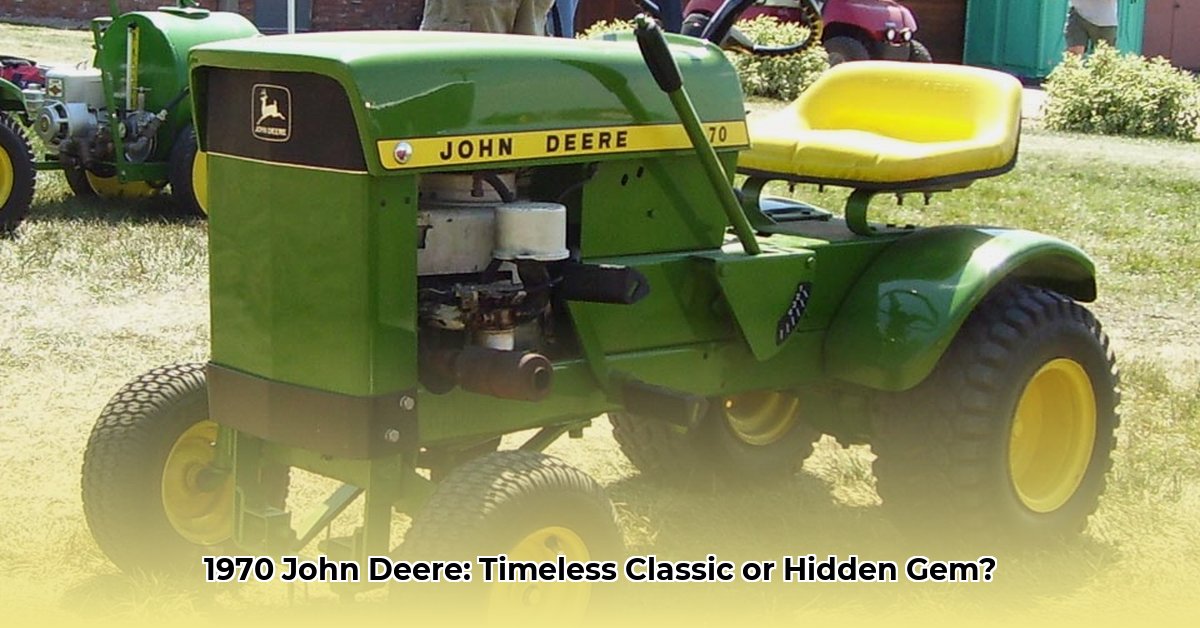
1970 John Deere 70 and 140: A Comparative Look at Iconic Lawn Tractors
The 1970s: a decade of bell bottoms, disco, and the rise of the perfectly manicured suburban lawn. Amidst this era of change, John Deere offered two iconic lawn tractors that reflected the evolving American Dream: the John Deere 70 and the John Deere 140. These weren't just machines; they represented a shift towards convenience and leisure, a status symbol embodying hard work and ease. But which model reigns supreme in the hearts (and garages) of collectors today? Let's delve into the details. For more on vintage tractors, see this helpful resource.
The John Deere 70: Simplicity and Rugged Reliability
The John Deere 70 epitomized no-nonsense engineering—a dependable workhorse prioritizing straightforward mechanics and reliable performance. Its manual transmission offered a direct, tactile connection to the machine, a feature often lost in modern, automated models. The robust gasoline engine easily handled most suburban lawns, and its simple design made maintenance relatively straightforward. This "if it ain't broke, don't fix it" philosophy contributed to its enduring popularity. Was this simplicity a strength or a limitation compared to its more technologically advanced counterpart?
The John Deere 140: A Technological Leap Forward
The John Deere 140 represented a remarkable technological advancement for its time. The introduction of hydrostatic transmission was revolutionary, allowing for effortless speed control via a simple lever instead of gear shifting. This innovation significantly enhanced ease of use and enjoyment. Furthermore, the 140’s hydraulic system enabled the attachment of various implements, transforming it from a simple mower into a versatile, year-round machine. This adaptability significantly expanded its appeal and practicality. But did this increased complexity come at the cost of increased maintenance demands?
John Deere 70 vs. 140: A Head-to-Head Comparison
To fully appreciate the differences, let's compare key specifications:
| Feature | John Deere 70 | John Deere 140 |
|---|---|---|
| Transmission | Manual | Hydrostatic |
| Hydraulics | None | Standard (on many models) |
| Engine Type | Gasoline | Gasoline |
| Ease of Use | Straightforward, simple operation | Easier speed control, more features |
| Maintenance | Generally easier | Potentially more complex |
| Collector Value | Increasing steadily | High, especially for mint condition |
Beyond the Mechanics: Reflecting the American Dream
These tractors weren't just tools; they symbolized the changing American landscape of the 1970s. Owning a John Deere 70 or 140 represented a step up in lifestyle, reflecting increased prosperity and a desire for convenient leisure. They're tangible pieces of Americana, weaving a rich narrative of technological advancements and social trends.
The Collector's Perspective: Preserving a Piece of History
Today, these machines offer collectors a captivating blend of history, engineering, and nostalgia. Finding a pristine example is a rewarding treasure hunt, and restoring one becomes a deeply satisfying endeavor. Online communities provide invaluable resources and support for restoration projects. This isn't merely collecting; it's preserving a piece of history and connecting with a past era of remarkable ingenuity. What's even more compelling? Their value is steadily appreciating as fewer and fewer of these machines remain.
The Verdict: Choosing Your Legacy Piece.
The ultimate choice between the John Deere 70 and 140 hinges on personal preference and collecting objectives. The 70 appeals to those who value simplicity and straightforward mechanics, while the 140 attracts enthusiasts who appreciate technological innovation and versatility. Both represent pivotal moments in lawn care technology and American history, and owning either is a testament to a passion for vintage machinery. Which model speaks to your heart… and your garage?
John Deere 140: Long-Term Reliability and Maintenance Considerations
The John Deere 140, produced from 1968 to 1974, offers a fascinating study of incremental design improvements impacting reliability and user experience. While both the 140 and 70 boast a reputation for durability, understanding their design nuances is crucial for collectors and restoration enthusiasts. The 140's simplicity, absent of complex electronics present in modern machines, offers easier maintenance and repair, contributing to its enduring appeal.
"The Kohler K series engine, common in many 140s, is known for its remarkable longevity," states Mark Johnson, a retired mechanical engineer and John Deere enthusiast. "However, consistent maintenance is pivotal; neglect will prove costly."
Hydrostatic transmissions, while offering smooth operation, can be surprisingly delicate. Worn transmissions pose significant challenges. Consider that model-year variations impacted transmission design and reliability; later models often featured improvements.
Other components, such as the braking system and electrical system, also underwent changes over the years, reflecting a push for increased reliability but also introducing potential maintenance issues associated with aging components. For example, early models used disc brakes, while later versions switched to drum brakes, each presenting different maintenance requirements.
Thorough research is paramount before purchasing a 140. Model-year variations had a significant impact on reliability and performance.
The John Deere 140 represents a remarkable combination of simplicity and technological advancement. Its long-term reliability hinges on diligent maintenance and a deep understanding of its unique design evolution. Owning one requires commitment and expertise but yields significant rewards for enthusiasts.